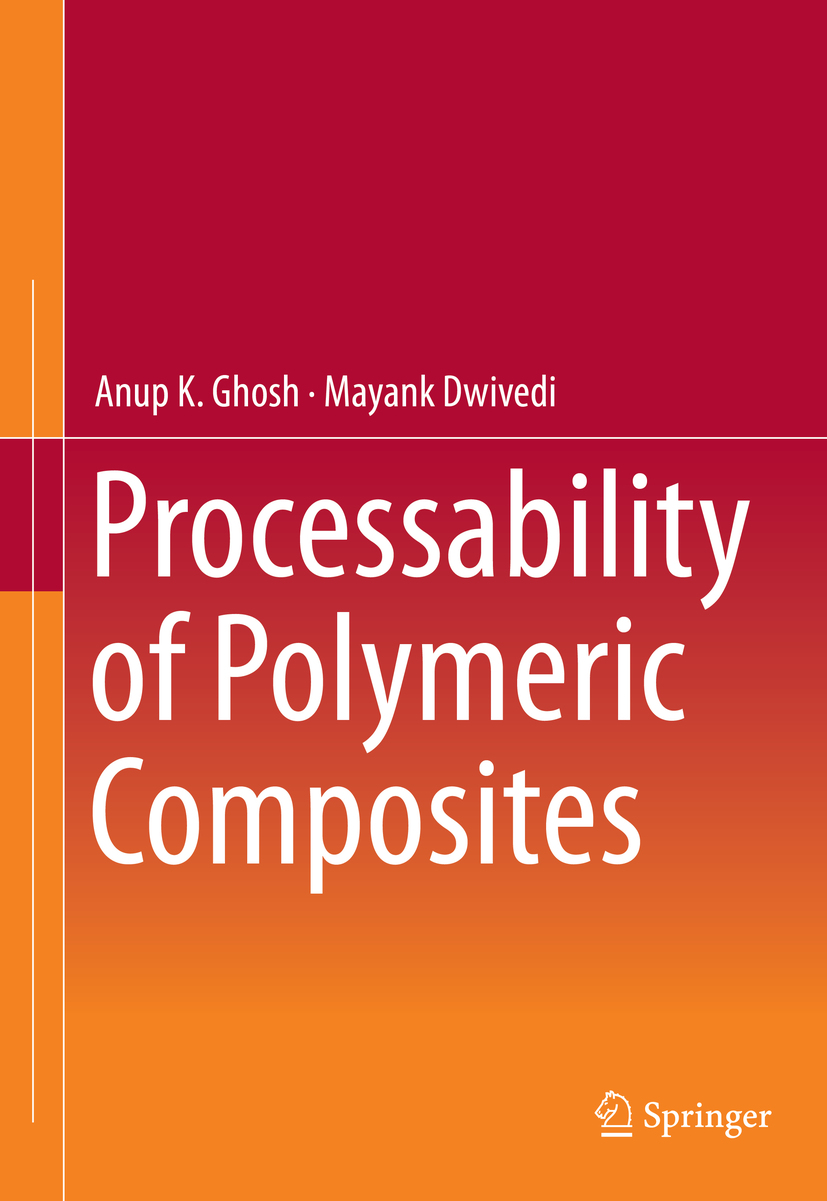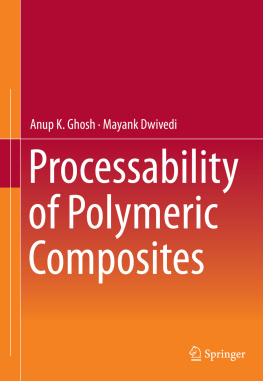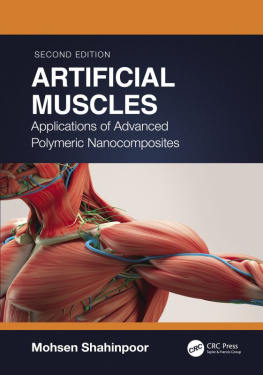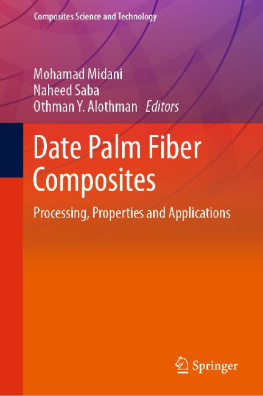Anup K. Ghosh - Processability of Polymeric Composites
Here you can read online Anup K. Ghosh - Processability of Polymeric Composites full text of the book (entire story) in english for free. Download pdf and epub, get meaning, cover and reviews about this ebook. year: 2020, publisher: Springer India, genre: Children. Description of the work, (preface) as well as reviews are available. Best literature library LitArk.com created for fans of good reading and offers a wide selection of genres:
Romance novel
Science fiction
Adventure
Detective
Science
History
Home and family
Prose
Art
Politics
Computer
Non-fiction
Religion
Business
Children
Humor
Choose a favorite category and find really read worthwhile books. Enjoy immersion in the world of imagination, feel the emotions of the characters or learn something new for yourself, make an fascinating discovery.
- Book:Processability of Polymeric Composites
- Author:
- Publisher:Springer India
- Genre:
- Year:2020
- Rating:3 / 5
- Favourites:Add to favourites
- Your mark:
- 60
- 1
- 2
- 3
- 4
- 5
Processability of Polymeric Composites: summary, description and annotation
We offer to read an annotation, description, summary or preface (depends on what the author of the book "Processability of Polymeric Composites" wrote himself). If you haven't found the necessary information about the book — write in the comments, we will try to find it.
Processability of Polymeric Composites — read online for free the complete book (whole text) full work
Below is the text of the book, divided by pages. System saving the place of the last page read, allows you to conveniently read the book "Processability of Polymeric Composites" online for free, without having to search again every time where you left off. Put a bookmark, and you can go to the page where you finished reading at any time.
Font size:
Interval:
Bookmark:


This Springer imprint is published by the registered company Springer Nature India Private Limited
The registered company address is: 7th Floor, Vijaya Building, 17 Barakhamba Road, New Delhi 110 001, India
Processing of advanced composites has witnessed a phenomenal growth over the last few decades. It is expected to grow at even a much faster rate due to the emergence of new processing technologies and the availability of a range of reinforcements and matrices. The choices offered by the variety of reinforcements and matrices pose a challenge to selecting the right combinations of materialsnot only from the point of view of the desired properties of the end product but also from the processability. Both quality and cost-effectiveness are also addressed. The availability of various processing technologies and their combination makes this task further complex.
Processability is the capability of any system or material to be converted into the desired outcome or product. The processability in advanced composites is influenced by many factors, such as the chemical nature of the matrix and reinforcement, interactions between phases, physical dimension of the reinforcement, additives, surface treatments on reinforcement, rheology of the matrix or system, temperature, pressure, and so on. Processability of constituents of composites is the key to processing advanced composites for a desired outcome. In this pursuit, there will be a greater demand for trained and highly skilled manpower now than before. Keeping this demand in mind, the authors have written this book for the students, engineers, and technologists who are pursuing a career in the field of processing advanced composites.
This book covers various topics of interest with special references to distinct characteristics of processability in the processing of advanced composites. It starts with Chap., which explains processability and its dimensions. This chapter further describes the classification of advanced composites, properties (physical mechanical, chemical, thermal, etc.) of matrices and reinforcements, and types of reinforcements (in terms of fibres, weaves, particulate, whiskers, etc.). It also discusses factors for quantitative understanding of processability.
In order to make our readers appreciate the potential of polymeric composites in various sectors, applications and advantages of polymeric composites are discussed in Chap.. This chapter gives an insight to the enormity of polymeric composites. It is stressed that the processability aspects for advanced composites have a direct impact on the performance of the product.
Chapterdiscusses micromechanics and macromechanics of advanced composites to impart a better understanding of composites and their mechanical behaviours under stress and strains. This chapter outlines theories for the basic understanding of the performance of advanced composites including the modes of failures. The influence of interfaces of a matrix and reinforcement for creating interphases in advanced composites and role of interphases in the composites are also emphasized in this chapter.
The rheology of a matrix and the rheology of a matrix under the influence of reinforcement are explained in Chap.. The important aspects of processability of thermoset matrices, thermoplastic matrices, and organic/inorganic/hybrid reinforcements are discussed. The selection methodology for matrices and reinforcement in regard to their processability and to develop desired composite product is explained. The differences between theoretical assessment and practical realities in processing, depending on the processability of advanced composite, are emphasized in this book. The processability of preforms and prepregs is also mentioned for a broader understanding of the readers in the area of advanced composite manufacturing. These discussions provide an assessment on the processability of advanced composites and the role of its constituents.
Polymeric composites and their processing technologies are discussed in Chaps.discusses the processability of thermoplastic composites. Thermosetting composites are considered to be workhorse of composite industries. The role and functions of thermosetting matrices, interaction with reinforcement, and compatibility with processing technology have been elaborated. On similar lines, the roles, interactions, and compatible processing technologies of thermoplastic matrices have been discussed from the point of processability.
The processing of composites is an intensive study; therefore, the selection of processing technologies for making composite products plays an important role for the desired outcome and properties. The processability aspects of open mould processing technologies (hand layup, filament winding, tape winding, etc.) are deliberated in Chap.. Closed mould processing technologies (matched die moulding, compression moulding, autoclaving, injection moulding, extrusion, pultrusion, etc.) are used for production of composite products with high dimensional accuracies. The cost of the product depends upon processing technologies.
The efficacy of processability of advanced composites is vindicated by the quality of the resultant composite product. Therefore, Chap.also discusses the structureproperty relationship in composites.
This book is focused on the processability of advanced composites with respect to various processing technologies. It provides much-needed insight on the processability aspects suiting specific processing technologies. This book covers a broad horizon on various aspects of processability to enable the reader to assess and correlate advanced composites manufactured by different processing technologies. This will help students, engineers, and technologists to select right processing technology for processing specific advanced composites.
Font size:
Interval:
Bookmark:
Similar books «Processability of Polymeric Composites»
Look at similar books to Processability of Polymeric Composites. We have selected literature similar in name and meaning in the hope of providing readers with more options to find new, interesting, not yet read works.
Discussion, reviews of the book Processability of Polymeric Composites and just readers' own opinions. Leave your comments, write what you think about the work, its meaning or the main characters. Specify what exactly you liked and what you didn't like, and why you think so.










